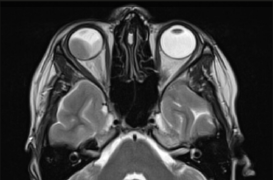Uveal melanoma is the most common intraocular tumour in adults, it is a form of cancer that affects mostly older adults, as the average age at detection of this tumour is 60 years, but it can occur in any age group with no significant gender difference. However, uveal melanoma is very rare in children compared to the adult population, accounting for 1 % of all cases. In pediatric patients, malignant uveal melanoma is more frequently manifested during puberty, leading to speculation of an association between uveal melanoma and growth hormone levels. Prognostic factors for uveal melanoma include tumour histology, chromosomal abnormalities, tumour size, extrascleral spread and tumour location. Risk factors for uveal melanoma include melanocytosis, neurofibromatosis type 1 and dysplastic naevus syndrome. Some studies point to a significantly lower risk of developing metastases in younger patients, but the prognosis of uveal melanoma in children is not yet fully known. Clinical signs and treatment options for malignant uveal melanoma in children are still under discussion. Differential diagnosis of uveal lesions in children can sometimes be very difficult, as evidenced by following case report in which authors describe a case of choroidal melanoma in a 15-year-old girl.
- Neurotransmission in Visual Analyser and Bionic Eye. A Review
- Amniotic Membrane Transplantation at the Department of Ophthalmology, University Hospital Brno
- Lateral Tarsal Strip Technique in Correction of Eyelid Ectropion and Entropion
- Diagnostics of Optic Disc Drusen in Children with Swept Source OCT Imaging
- Bilateral Eye Injury with Bilateral Blowout Fracture Caused by High-pressure Water Jet in 16-year-old Female Firefighter. Case Report
- Uveal Melanoma In A 15-Year-Old Girl. Case Report

